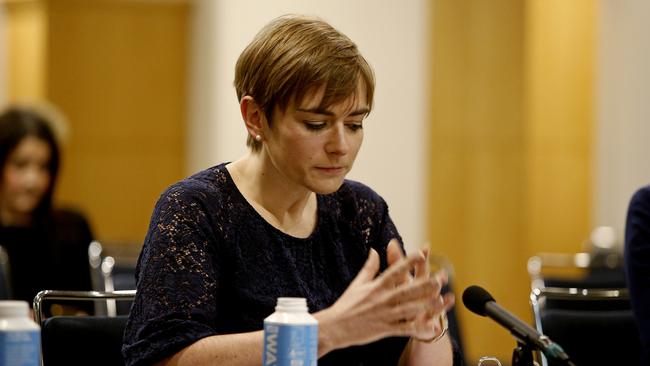Union blast for RBA over ‘jobs market too hot’
Union leaders have accused the Reserve Bank of signalling that ‘workers should get the sack’ after its chief economist Sarah Hunter said the labour market was still too tight and driving inflation.

You can now listen to The Australian's articles. Give us your feedback.
Union leaders have accused the Reserve Bank of signalling that “workers should get the sack” after the central bank’s chief economist made it clear that a resilient jobs market was still running too hot and exacerbating inflation.
With cash-strapped households facing a long wait into the new year for the prospect of rate cuts, RBA assistant governor Sarah Hunter gave a speech on Wednesday expressing surprise at the strength of the labour force despite stalling growth.
“Our current assessment is that the labour market is operating above full employment but has moved towards better balance since late 2022,” Dr Hunter told a summit hosted by investment bank Barrenjoey.
Under the RBA’s agreement with government, the central bank has the objective of achieving “full employment” – the maximum level of employment consistent with inflation holding within its 2 to 3 per cent target band.
Australian Manufacturing Workers Union national secretary Steve Murphy said “on the surface, that sounds as if the RBA is saying in code that workers should get the sack and pay the price for an economy that is being heated up by greed”.
“This is very clear that the RBA is out of touch,” he said. “Working people are struggling and under a cost-of-living crisis that’s been caused by price gouging by big corporations using their market share to rip us off.”
Health Services Union national secretary Gerard Hayes said “what they (the RBA) need to do, as opposed to destroying families and seeing family units fall apart … (is) look at how to broaden that base so that everybody is encouraged not to spend as much.”
While Australia’s unemployment rate has inched higher in recent months – climbing from a near-record low of 3.5 per cent in mid-2023 to 4.2 per cent in July as the RBA’s run of rate hikes work to curtail economic growth – it remains low by historical standards.
The continued resilience of the jobs market has been cited by RBA governor Michele Bullock as a reason behind the central bank’s decision to hold the cash rate at its current 12-year high of 4.35 per cent.
With economic growth slowing to a crawl in the June quarter, Dr Hunter said it was “somewhat surprising” key indicators across the jobs market, including hours worked and underemployment, had remained so resilient.
“Taken together, they suggest that conditions in the labour market remain tighter than implied by full employment,” she said.
Australia’s participation rate – the share of people in work or looking for work – hit a record 67.1 per cent in July.
“This has not been the experience in most other peer economies. Whereas participation rates amongst this group have largely begun to stabilise, in Australia the participation rate has continued to increase steadily in the post-pandemic period,” Dr Hunter said.
Deutsche Bank chief economist Phil O’Donoghue said the jobs market was still stronger than a level consistent with the inflation target. “If the labour market doesn’t weaken further over coming months, it will be very difficult for the RBA to get inflation back to target,” he said.
With weakness in the jobs market coming from a reduction in hours worked rather than an outright loss of jobs, Mr O’Donoghue said the strength of the labour market was weighing against precautionary savings
“People are still employed – that’s adding to aggregate demand,” he said. “People are confident about their jobs … and so, in a relative sense, they’re willing to keep spending.”
Dr Hunter said jobs growth had been uneven across the economy “with aggregate employment supported by strong growth in the health, education and public administration sectors”.
The economy has experienced a surge in taxpayer-funded “non-market” jobs in the past two years, as federal and state governments ramp up outlays to fund social benefits including aged care, the NDIS, childcare and other health-related programs, driving demand for additional workers.
Even as the RBA expects the economy would continue to add jobs, Dr Hunter said it expected the unemployment rate to rise further, reaching 4.4 per cent by mid 2025. She warned that our strong jobs market could take a turn for the worst if the “unemployment rate rises more quickly than we expect.”
AMP economist Diana Mousina said there was a risk the RBA was underestimating how far and how quickly tightness in the labour market could unwind.



To join the conversation, please log in. Don't have an account? Register
Join the conversation, you are commenting as Logout